May 10,2006
I am in Xian, which was the capital of China a thousand years ago–and had been the capital for a thousand years.
We have had a very busy routine, but I’m delighted that I have some students who are as interested as I am in wandering around in the mornings and in those few hours that we have free time. As I mentioned, we flew over the North Pole, the new direct route from Chicago that reduces the flight to “only” 13 1/3 hours. That was about 2 hours sleep, three meals, four
movies, and one interesting book on Wal-Mart for me.
It was fun, as it always is for me, to come back to Beijing. The city is, like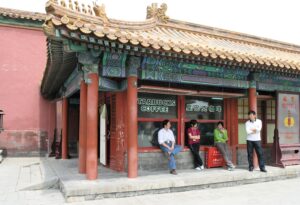 most capitals, imperious and imperial. The old is impressive, the new, impressive if you have my perspective, which goes back to 1990. There has been a controversy about the Starbucks (gasp) in the Forbidden City. I suspect it will be gone eventually, along with the mayor who approved it. Ironically, it is an internet citizen crusade that has been spearheading the demand for its demise.
most capitals, imperious and imperial. The old is impressive, the new, impressive if you have my perspective, which goes back to 1990. There has been a controversy about the Starbucks (gasp) in the Forbidden City. I suspect it will be gone eventually, along with the mayor who approved it. Ironically, it is an internet citizen crusade that has been spearheading the demand for its demise.
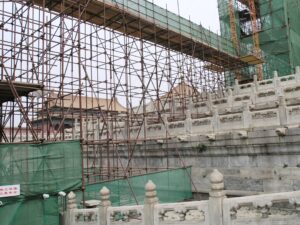 The city is preparing for the Olympics, and refurbishing its sights, which means there were several places (including the Forbidden City) which were “forbidden” because they were closed or parts were closed. One morning, I took some students to my favorite park (Jing Shan) which overlooks the Forbidden City. It’s where the last Ming emperor hanged himself (in 1644).
The city is preparing for the Olympics, and refurbishing its sights, which means there were several places (including the Forbidden City) which were “forbidden” because they were closed or parts were closed. One morning, I took some students to my favorite park (Jing Shan) which overlooks the Forbidden City. It’s where the last Ming emperor hanged himself (in 1644).
We climbed the hill overlooking the Forbidden City–only to find the pavilion was being reworked, so we had only glimpses of grandeur.
My fellow teacher, Ruth Ann Friedberg, with whom I traveled last time, and I have somewhat different interests, so we can offer students 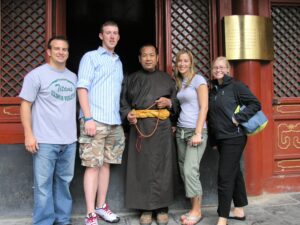
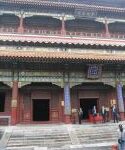 different options when we have free time. For example, our last day in Beijing, we had a visit to the Chestnut operation in Beijing, and then had the afternoon to wander. About half the students elected to take a tour of the (refurbished) hutongs, the traditional houses of Beijing, which involved a rickshaw ride. I offered an alternative, which was to see the real hutongs and to visit one of
different options when we have free time. For example, our last day in Beijing, we had a visit to the Chestnut operation in Beijing, and then had the afternoon to wander. About half the students elected to take a tour of the (refurbished) hutongs, the traditional houses of Beijing, which involved a rickshaw ride. I offered an alternative, which was to see the real hutongs and to visit one of 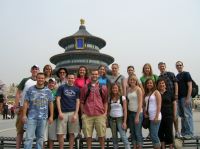 the temples. Ruth Ann needed to shop, but wanted also to see one of the temples, so we escorted about half the students to the Lama Temple, which was the location of the Tibetan monks in Beijing. It’s one of my favorite places anyway–with the half-man, half-animal versions of the Buddha followers. Having been to Tibet gave me a new perspective.
the temples. Ruth Ann needed to shop, but wanted also to see one of the temples, so we escorted about half the students to the Lama Temple, which was the location of the Tibetan monks in Beijing. It’s one of my favorite places anyway–with the half-man, half-animal versions of the Buddha followers. Having been to Tibet gave me a new perspective.
We parted. I took the Fred followers to Liulichang, an older area with real hutongs (without indoor plumbing and without air conditioning, 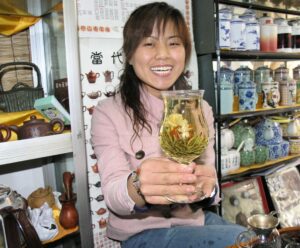 and some without water), and traditional shopping. That was neat, since there’s a tea shop that JR and I discovered two years ago, revisited last year, and he was there in March. We spent about an hour with the owner, sampling teas (I do like the lichi red and 8 treasures, which are not available in the US) and departed with tea and memories. We took the subway around and felt like real Beijingers.
and some without water), and traditional shopping. That was neat, since there’s a tea shop that JR and I discovered two years ago, revisited last year, and he was there in March. We spent about an hour with the owner, sampling teas (I do like the lichi red and 8 treasures, which are not available in the US) and departed with tea and memories. We took the subway around and felt like real Beijingers.
As many times as I visit Beijing, I’m still in awe. I can only imagine what it might have been like for foreigners, who came from lesser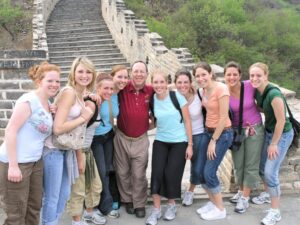 civilizations (as I sometimes think we do–we have little that’s a thousand years old) to walk the Sacred Way (to the tombs of the Ming emperors), or to walk through the Forbidden City for the coveted audience with the emperor or to walk the Great Wall and realize that it was built almost 2000 years ago. Pretty
civilizations (as I sometimes think we do–we have little that’s a thousand years old) to walk the Sacred Way (to the tombs of the Ming emperors), or to walk through the Forbidden City for the coveted audience with the emperor or to walk the Great Wall and realize that it was built almost 2000 years ago. Pretty 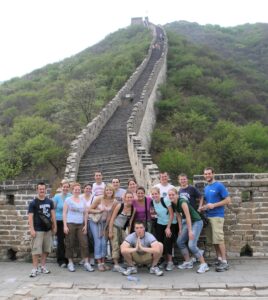 overwhelming
overwhelming
The train to Xian was fun, too. 12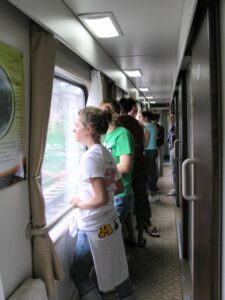 hours, but overnight, so we got on and were on for most of the evening. We arrived in Xian in time to visit several Buddhist pagodas from 600 ad, to have dumpling dinner, and to wander through the Muslim area.
hours, but overnight, so we got on and were on for most of the evening. We arrived in Xian in time to visit several Buddhist pagodas from 600 ad, to have dumpling dinner, and to wander through the Muslim area.
Today, the underground army.
Gotta run for breakfast. JR used to say it’s like scout camp, and it is–except I have never had fresh waffles with chocolate sauce at Scout camp.